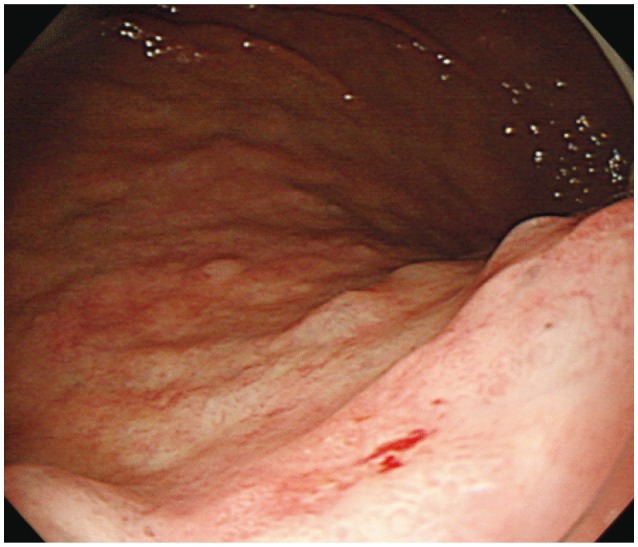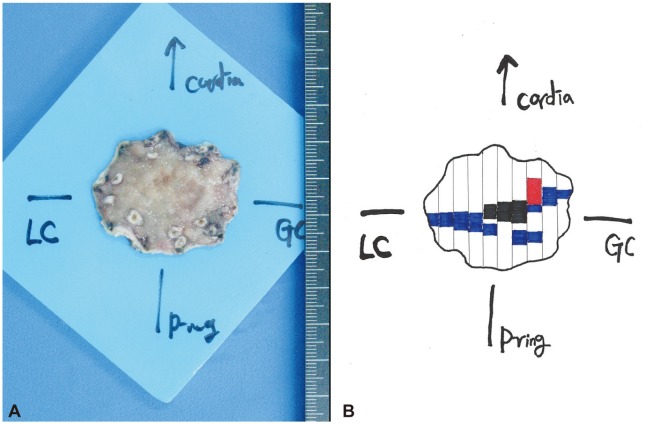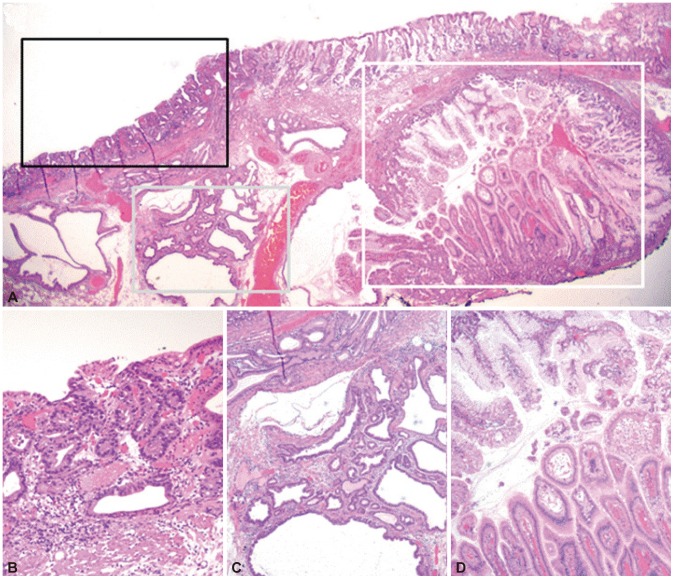Abstract
A gastric inverted hyperplastic polyp is a rare type of gastric polyp and is characterized by downward growth of a variety of mucosal components into the submucosa. The polyp consists of columnar cells resembling foveolar epithelium and pyloric gland epithelium and can coexist with gastritis cystica profunda. Frequently, adenocarcinoma can coexist, but the relation is not clear. A 77-year-old male underwent endoscopic submucosal dissection due to early gastric cancer. A gastric inverted hyperplastic polyp was found in the removed specimen and gastric cystica profunda was also found. We report a case of gastric inverted hyperplastic polyp coexisting with gastric cystica profunda and gastric adenocarcinoma.
Gastric inverted hyperplastic polyp (IHP) is a rare type of gastric polyp and is marked by downward growth of hyperplastic mucosal component into the submucosa. Generally, gastric hyperplastic polyps grow upward to the lumen of the stomach, but gastric IHP grows downward into the submucosa. Therefore, the polyp is formed in the submucosa. The polyp is composed of foveolar-type cells, pyloric gland-like cells, and smooth muscle cells. In 1993, Kamata et al.1 termed the lesion inverted hyperplastic polyp. As far as we know, one case has been reported previously in Korea.2 A total of six cases of gastric IHP coexisting with gastric adenocarcinoma have been reported in the world.3
Here, we report a case of gastric IHP coexisted with metachronous early gastric cancer managed successfully by the endoscopic submucosal dissection.
A 77-year-old male was admitted to undergo gastric endoscopic submucosal dissection. He had been diagnosed with a metachronous early gastric cancer on the posterior wall of the mid body 2 weeks before the admission. In the past history, he had undergone endoscopic submucosal dissection due to early gastric cancer on the anterior wall of the antrum of the stomach and gastric polypectomy due to multiple hyperplastic polyps in the stomach 1 year and 8 months before the admission. On admission, the physical examination was unremarkable. Complete blood count results showed white blood cell of 5,800/mm3, hemoglobin of 13.1 g/dL, and platelet of 214,000/mm3. The blood chemistry was analyzed as total protein of 7.6 g/dL, albumin of 4.1 g/dL, total bilirubin of 0.6 mg/dL, aspartate aminotransferase of 33 IU/L, alanine aminotransferase of 23 IU/L, alkaline phosphatase of 51 IU/L, serum creatinine of 1.4 mg/dL, total cholesterol of 176 mg/dL, and fasting blood glucose of 97 mg/dL. Endoscopic examination demonstrated superficial depressed lesion with spontaneous bleeding on the posterior wall of the mid body (Fig. 1). He underwent endoscopic submucosal dissection successfully.
The resected specimen was 4.5×3×0.5 cm and had 1.5×0.5-cm superficial depressed lesion in the center (Fig. 2). Microscopically, 1.5×0.5-cm-sized, well-differentiated tubular adenocarcinoma was noted. It was confined to the mucosa and did not have involvement of lateral and deep margins, lymphatic invasion, vascular invasion, and perineural invasion. In addition, gastritis cystica profunda was also noted in the submucosa. Especially, nodular inverted proliferation of the normal appearing gastric epithelium and glands in the submucosa was noted in the center of the resected specimen. It measured 5 mm and showed mild glandular atypia. It was diagnosed to be a gastric IHP (Fig. 3). He was discharged without special complications after the endoscopic submucosal dissection.
Gastric IHP is characterized by marked submucosal glandular proliferation associated with cystic dilation, leading to a polypoid lesion. The main location is the submucosa or the inside of the muscularis mucosae. Similar lesions arising in the colon have been reported as colonic IHP.4 Colonic IHP differs clinically from exophytic hyperplastic polyps by being more frequent on the right side than in the left colon and being relatively more common in women. Colonic IHP, coexisting with colitis cystica, relates to colonic malignancy.4
In Kono et al.'s report3 analyzing 32 gastric IHP cases (in 30 patients), the mean age was 55.6 years (range, 8 to 81), consisting of 14 male and 16 female patients. Fifteen of the 32 gastric IHPs were located in the fundus, 12 in the body, and five in the antrum of the stomach. The size of the lesion varied and six of the 32 IHPs were greater than 3 cm in diameter. The glandular components of gastric IHP comprised fundic type epithelium in 13 cases, and foveolar-type epithelium and pylorictype epithelium or another intermediate-type epithelium in the remaining 19 cases. Gastritis cystica profunda in the background of the stomach has been reported in only two cases.
In our case, gastric IHP was located in the body and showed foveolar-type epithelium and pyloric-type epithelium. One notable feature of our case was accompanying adenocarcinoma in the mucosa. According to Kono et al.'s report,3 six of the reported 30 patients had synchronous gastric cancer. The adenocarcinoma developed separately from the IHP in five patients. But the adenocarcinoma developed from IHP itself in only one patient. As gastric IHP is very rare, the relation between gastric IHP and adenocarcinoma has not been known until now. However, the frequency is considerably higher compared with the incidence of gastric carcinoma occurring in the general population. Therefore, it may be necessary to evaluate the presence of adenocarcinoma in IHP patients.
In our case, gastritis cystica profunda was also noted in the submucosa. Gastritis cystica profunda (GCP) is an uncommon hyperplastic benign lesion, and histologically characterized by hyperplasia and cystic dilatation of the gastric glands extending into the submucosal layer. GCP usually occurs at a gastroenterostomy site, although it can occasionally be found in an unoperated stomach. GCP is considered to be a benign disease, but it is thought to be a possible precancerous lesion, since a few gastric cancers were reported to be associated with it.5-9 Both IHP and GCP are located in the submucosa and are composed of benign glandular components associated with cystic dilatation. IHP revealed hyperplastic glands composed of epithelium of foveolar-type cells, pyloric gland-like cells, and smooth muscle cells. On the other hand, GCP is usually composed of simple, glandular components without hyperplastic changes.10 If there is a submucosal glandular displacement, it may be difficult to distinguish between IHP and GCP. Although Yamashita et al.11 proposed the possibility that IHP may be associated with hyperplastic changes of GCP, further studies are necessary to clarify the association between IHP and GCP.
We reported a case of gastric IHP associated with GCP and EGC. Therefore, precise endoscopic examination may be necessary to rule out gastric malignancy in IHP patients.
References
1. Kamata Y, Kurotaki H, Onodera T, Nishida N. An unusual heterotopia of pyloric glands of the stomach with inverted downgrowth. Acta Pathol Jpn. 1993; 43:192–197. PMID: 8493869.

2. Choi MS, Jin SY, Kim DW, Lee DW, Park SM. A case of gastric inverted hyperplastic polyp associated with gastritis cystica profunda and early gastric carcinoma. Korean J Pathol. 2007; 41:55–58.
3. Kono T, Imai Y, Ichihara T, et al. Adenocarcinoma arising in gastric inverted hyperplastic polyp: a case report and review of the literature. Pathol Res Pract. 2007; 203:53–56. PMID: 17097828.

4. Sobin LH. Inverted hyperplastic polyps of the colon. Am J Surg Pathol. 1985; 9:265–272. PMID: 4014540.

5. Cho HJ, Kim JE, Jeong BJ, et al. A case of gastric adenocarcinoma arising from gastritis cystica profunda. Korean J Gastrointest Endosc. 2004; 28:237–241.
6. Jo MA, Kim SH, Kim SH, et al. A case of gastritis cystica profunda with early gastric cancer. Korean J Med. 2004; 67:78–82.
7. Kim JY, Hur H, Cho YK, Han SU. gastric cancer associated with gastritis cystica profunda in patients without previous gastric surgery. J Korean Surg Soc. 2010; 79(Suppl 1):S26–S30.

8. Lee HJ, Lee TH, Lee JU, et al. Clinical features of gastritis cystica profunda in patients without history of gastric surgery (gastric cancer patients vs. non-cancerous patients). Korean J Med. 2006; 71:511–517.
9. Moon SY, Kim KO, Park SH, et al. Gastritis cystica profunda accompanied by multiple early gastric cancers. Korean J Gastroenterol. 2010; 55:325–330. PMID: 20697192.

10. Franzin G, Novelli P. Gastritis cystica profunda. Histopathology. 1981; 5:535–547. PMID: 7286916.

11. Yamashita M, Hirokawa M, Nakasono M, et al. Gastric inverted hyperplastic polyp: report of four cases and relation to gastritis cystica profunda. APMIS. 2002; 110:717–723. PMID: 12583438.

Fig. 1
Gastroscopic finding. A 1.5-cm superficial depressed lesion surrounded by multiple nodularity with overlying normal mucosa is observed at the mid body of the stomach. In the center of the lesion, spontaneous bleeding is noted.

Fig. 2
Gross finding. (A) An endoscopic submucosal dissection (ESD) specimen, measuring 4×3.5×0.5-cm shows 1.5×0.5-cm superficial depressed lesion in the center and multiple markings on the periphery. (B) Mapping of ESD specimen reveals 1.5×0.5-cm-sized, well-differentiated, tubular adenocarcinoma (black color) in the center and gastritis cystica profunda (blue color) multifocally. An inverted hyperplastic polyp is located close to the well-differentiated tubular adenocarcinoma (red color). LC, lesser curvature; GC, greater curvature.

Fig. 3
Microscopic finding. (A) Low power view of the lesion shows well-differentiated adenocarcinoma in the mucosa (black box), gastritis cystica profunda in the submucosa (gray box), and inverted hyperplastic polyp in the submucosa (white box) at the same sight (H&E stain, ×10). (B) Well-differentiated adenocarcinoma is noted in the epithelium and lamina propria (black box, H&E stain, ×100). (C) It shows hyperplasia and cystic dilatation of the gastric glands extending to the submucosa layer (gray box, H&E stain, ×40). (D) It reveals a submucosal mass composed of proliferative glandular epithelial cells showing papillary and glandular growth (white box, H&E stain, ×40).





 PDF
PDF ePub
ePub Citation
Citation Print
Print


 XML Download
XML Download